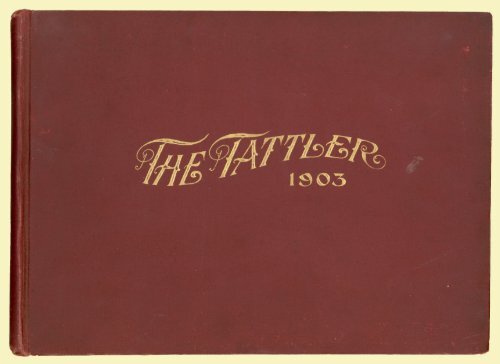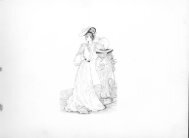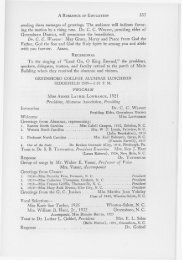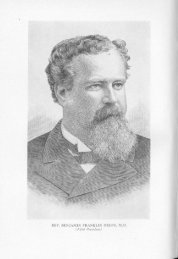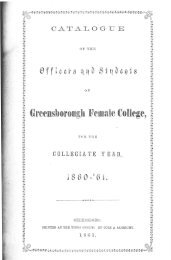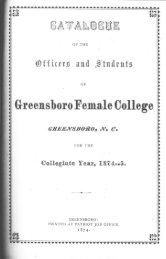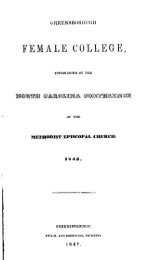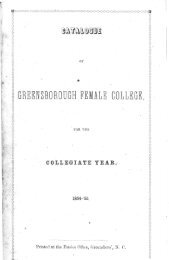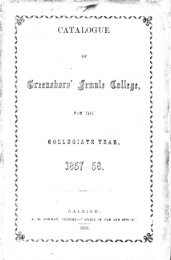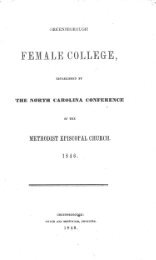Laura Crump - Brock Historical Museum of Greensboro College
Laura Crump - Brock Historical Museum of Greensboro College
Laura Crump - Brock Historical Museum of Greensboro College
Create successful ePaper yourself
Turn your PDF publications into a flip-book with our unique Google optimized e-Paper software.
THE TATTLER<br />
PUBLISHED BY STUDENT-BODY GREENSBORO FEMALE COLLEGE<br />
G R E E N S B O R O<br />
1903<br />
N O R T H CAROLINA
TO<br />
Mrs. <strong>Laura</strong> <strong>Crump</strong> Patrick<br />
THE ONLY SURVIVING MEMBER<br />
O F THE CLASS OF 1848,<br />
THE FIRST GRADUATED FROM<br />
GREENSBORO FEMALE COLLEGE
MRS. LAURA CRUMP PATRICK.
MRS. LUCY H. ROBERTSON, PRESIDENT.
Main Building
W. R. ODELL<br />
J. A. ODELL<br />
DRED PEACOCK<br />
J. M. ODELL O. W. CARR<br />
President<br />
Secretary<br />
Treasurer<br />
C. H. IRELAND B. N. DUKE<br />
Executive Committee<br />
J. A. ODELL, President O. W. CARR, Secretary<br />
C. H. IRELAND<br />
8
C. H. IRELAND O. W. CARR DRED PEACOCK<br />
J. M. ODELL J. A. ODELL W. R. ODELL
HE history <strong>of</strong> <strong>Greensboro</strong> Female <strong>College</strong> antedates<br />
by many years that great civil struggle which<br />
may be regarded as the watershed dividing those<br />
two great streams <strong>of</strong> life, the Old and the New<br />
South, and stretches back into that remote, and some-<br />
what vague and hazy period so <strong>of</strong>ten referred to in South-<br />
ern parlance as “before the war.’’<br />
Chartered in 1838, it is the second oldest chartered<br />
college for women in the South, and was among the first<br />
institutions <strong>of</strong> learning for advanced education <strong>of</strong> girls<br />
at a time when the merest rudiments <strong>of</strong> learning, with a<br />
few shallow accomplishments, was considered all the in-<br />
tellectual development required in the restricted sphere to<br />
which women were relegated.<br />
This eldest daughter <strong>of</strong> the Methodist Church in North<br />
Carolina was called into existence by generous-hearted,<br />
large-brained men who realized that the Church owes to<br />
her daughters as good intellectual training as to her sons.<br />
With almost prophetic insight, seeing that the service <strong>of</strong><br />
Christian womanhood was to become an important factor<br />
in the great work <strong>of</strong> the evangelization <strong>of</strong> the world,<br />
they provided for the accomplishment <strong>of</strong> this mission by<br />
giving to the girls <strong>of</strong> the Church opportunities for both<br />
heart and brain culture. And right nobly have the<br />
daughters <strong>of</strong> the Church responded to the opportunity<br />
thus opened, for <strong>of</strong> the many hundreds who have passed<br />
through the portals <strong>of</strong> <strong>Greensboro</strong> Female <strong>College</strong>, few<br />
10<br />
History <strong>of</strong> <strong>College</strong><br />
have failed to answer the call <strong>of</strong> the Church, and <strong>of</strong> very<br />
many <strong>of</strong> them it may be said with truth, “ Many daugh-<br />
ters have done virtuously, but thou excellest them all.”<br />
Owing to delay growing out <strong>of</strong> widespread financial<br />
depression in the country at large, the corner-stone <strong>of</strong> the<br />
building was not laid until 1843. In 1846 it was ready<br />
for occupancy. The following fall Rev. Solomon Lea, a<br />
man <strong>of</strong> scholarly attainments, was chosen president, and<br />
with an able faculty, the school was opened to the girls<br />
<strong>of</strong> North Carolina ; and, indeed, to the entire South, for<br />
in those days <strong>of</strong> paucity <strong>of</strong> schools for advanced educa-<br />
tion <strong>of</strong> girls, the <strong>College</strong> drew to itself many from the<br />
far Southern States, who came by stage coach or by pri-<br />
vate conveyance to avail themselves <strong>of</strong> the advantages<br />
not afforded, at that time, in their own States.<br />
On the resignation <strong>of</strong> Mr. Lea, Rev. A. M. Shipp, <strong>of</strong><br />
South Carolina, was chosen as his successor, and admin-<br />
istered the affairs <strong>of</strong> the <strong>College</strong> wisely for three years,<br />
after which he resigned and accepted a pr<strong>of</strong>essorship in<br />
the University <strong>of</strong> North Carolina.<br />
Dr. Shipp was followed by Rev. Charles F. Deems,<br />
D. D., who was afterwards so widely known as the pastor<br />
<strong>of</strong> the Church <strong>of</strong> the Strangers in New York City. Under<br />
Dr. Deems the patronage was largely increased, and the<br />
<strong>College</strong> enjoyed an era <strong>of</strong> great prosperity. Doubtless,<br />
the intellectual vigor and robustness <strong>of</strong> character pos-<br />
sessed in a marked degree by Dr. Deems were powerful
moulding factors in the life <strong>of</strong> the <strong>College</strong> and have left<br />
a lasting impress.<br />
The fourth in this honorable line <strong>of</strong> succession was the<br />
man whose name was so long associated with <strong>Greensboro</strong><br />
Female <strong>College</strong> that in the memories <strong>of</strong> a large propor-<br />
tion <strong>of</strong> the old pupils <strong>of</strong> the <strong>College</strong>, from 1854-1890,<br />
the two are inseparable ; and at the name <strong>of</strong> Rev. T. M.<br />
Jones, D. D., hundreds <strong>of</strong> “old girls” rise up and call<br />
him blessed. Dr. Jones was a Christian scholar and a<br />
gentleman <strong>of</strong> the “old school” type, than which no<br />
higher has been developed ; and his refined and polished<br />
manner gave him peculiar adaptation to the position at<br />
the head <strong>of</strong> a school for girls. Thirty-six years <strong>of</strong><br />
abundant and fruitful labors in the cause <strong>of</strong> woman’s<br />
.education place him in the front rank <strong>of</strong> educators, not<br />
only in his own State, but in the South.<br />
It was during the presidency <strong>of</strong> Dr. Jones, when the<br />
<strong>College</strong> was in one <strong>of</strong> the most flourishing periods <strong>of</strong> its<br />
history, that a great calamity befell it in the destruction<br />
<strong>of</strong> the building by fire soon after the opening <strong>of</strong> the fall<br />
term in 1863. This misfortune necessitated a suspension<br />
<strong>of</strong> the school for ten years, though during that interval<br />
Dr. Jones, with practically the same faculty, was pursu-<br />
ing his beloved work at other points in the State.<br />
No sooner had the country begun to recover from the<br />
business paralysis resulting from war’s terrible devasta-<br />
tion than the North Carolina Conference begun to take<br />
steps for the restoration <strong>of</strong> <strong>Greensboro</strong> Female <strong>College</strong>.<br />
The corner-stone <strong>of</strong> the new building was laid in 1871,<br />
and Phoenix-like the <strong>College</strong> arose from her ashes, to<br />
11<br />
enter, August 27, 1873, upon a new career <strong>of</strong> usefulness<br />
and prosperity along educational lines under the guidance<br />
<strong>of</strong> her same president and members <strong>of</strong> the old faculty.<br />
The Church, in common with other institutions as well<br />
as individuals, was embarrassed financially after the war,<br />
and in spite <strong>of</strong> heroic struggles was unable to discharge<br />
the debt incurred in erecting the new building, and it<br />
seemed impossible for the Church to retain ownership <strong>of</strong><br />
this beloved daughter <strong>of</strong> the Church. At this crisis a<br />
syndicate <strong>of</strong> prominent laymen, actuated by the generous<br />
purpose <strong>of</strong> not allowing the <strong>College</strong> to pass from the con-<br />
trol <strong>of</strong> the Church, purchased the property in 1882, and<br />
have held it ever since, subject to the control <strong>of</strong> a board<br />
<strong>of</strong> directors, for educational purposes and as a school for<br />
the Methodist Church in North Carolina.<br />
Through these changing fortunes Dr Jones continued<br />
at the head <strong>of</strong> the institution until his greatly lamented<br />
death in June, 1890, when Dr. B. F. Dixon was chosen<br />
to succeed him. Dr. Dixon, by his genial, kindly nature,<br />
greatly endeared himself to his students, and during the<br />
three years <strong>of</strong> his presidency he attracted large numbers<br />
<strong>of</strong> girls to the <strong>College</strong>, and brought to it the largest pat-<br />
ronage in its history.<br />
Dr. Dixon having resigned in the spring <strong>of</strong> 1893, Dr.<br />
Frank I,. Reid, at that time editor <strong>of</strong> The Raleigh Chris-<br />
tian Advocate. was elected president <strong>of</strong> the faculty, enter-<br />
ing upon the duties <strong>of</strong> the position with vigor and<br />
earnestness. For one year he gave to the <strong>College</strong> his best<br />
thought and energy ; but in the midst <strong>of</strong> what promised<br />
to be a most successful career, at the beginning <strong>of</strong> the
fall term <strong>of</strong> 1894, he was suddenly called by death from<br />
earthly activities.<br />
Up to this point in its history the <strong>College</strong> had been pre-<br />
sided over by able and scholarly ministers <strong>of</strong> the Meth-<br />
odist Church. At this juncture a departure from previous<br />
traditions was made by the election <strong>of</strong> a layman to take<br />
the helm and guide the course <strong>of</strong> this honored old insti-<br />
tution. The board <strong>of</strong> directors realized that, in the able<br />
and scholarly young educator who, for six years, had<br />
filled a pr<strong>of</strong>essorship in the <strong>College</strong>, they already pos-<br />
sessed the man who was endowed with all the qualifica-<br />
tions requisite for the position, and Dr. Dred Peacock was<br />
called to the responsibility <strong>of</strong> directing the affairs <strong>of</strong> the<br />
<strong>College</strong>. With characteristic progressiveness <strong>of</strong> spirit,<br />
the first step <strong>of</strong> the new president was the complete<br />
reorganization <strong>of</strong> the <strong>College</strong> courses according to the<br />
most modern methods, and a general expansion <strong>of</strong> the<br />
work by enlarging the curriculum and providing better<br />
facilities for study by means <strong>of</strong> well-equipped laboratories<br />
and improved appliances in the various departments. But<br />
the most striking monument to Dr. Peacock’s energy and<br />
sagacity is the magnificent Library founded and endowed,<br />
in the name <strong>of</strong> Mrs. Peacock, as a loving memorial to their<br />
little daughter, Ethel Carr Peacock. The Library con-<br />
tains more than 7,000 carefully selected volumes, besides<br />
many valuable pamphlets and much magazine and other<br />
periodical literature, all <strong>of</strong> which has been collected<br />
through Dr. Peacock’s untiring effort to render this, as it<br />
is, the largest and best library in any college for women<br />
in the South. With this invaluable aid to research the<br />
12<br />
students are enabled to do a far higher grade <strong>of</strong> work in<br />
literature and history, as well as along other lines, than<br />
would be possible without it. Had Dr. Peacock not<br />
accomplished many other things <strong>of</strong> value for the <strong>College</strong>,<br />
this one achievement alone would entitle him to be re-<br />
garded as a great benefactor to the institution; but this<br />
was but one among many other wise measures carried out<br />
by him, and under his administration the <strong>College</strong> enjoyed<br />
eight prosperous years.<br />
In the spring <strong>of</strong> 1902 Dr. Peacock, having suffered<br />
several years from ill-health, was urged by a prominent<br />
specialist <strong>of</strong> New York to give up his educational work<br />
and to engage in more active business life as a means <strong>of</strong><br />
restoration to health. Acting upon this advice, Dr. Pea-<br />
cock <strong>of</strong>fered his resignation, and the board <strong>of</strong> directors<br />
decided upon another innovation in the election <strong>of</strong> the<br />
lady principal, Mrs. Lucy H. Robertson, to the presi-<br />
dency. Mrs. Robertson had been connected with the<br />
<strong>College</strong> eighteen years <strong>of</strong> her twenty-five years spent<br />
in teaching, and having filled several different depart-<br />
ments in the <strong>College</strong>, she was thoroughly conversant with<br />
all its workings, its aims, and its needs, and so was en-<br />
abled to adjust herself to the new relation without any <strong>of</strong><br />
the friction that might so easily arise in the inauguration<br />
<strong>of</strong> a new administration.<br />
The friends <strong>of</strong> the institution feel assured that it will<br />
be her constant purpose and endeavor to maintain the<br />
high standard for which the <strong>College</strong> has ever stood from<br />
its foundation. Although she is just closing her first year<br />
as president, she has manifested a spirit <strong>of</strong> progress that
shows her to be in full touch with the advance movement<br />
which has characterized the history <strong>of</strong> the school, espe-<br />
cially in later years. A further reorganization <strong>of</strong> the<br />
course <strong>of</strong> study has been made by which the requirements<br />
for graduation have been made equal to those <strong>of</strong> any, and<br />
in advance <strong>of</strong> most Southern colleges for girls. The<br />
social life <strong>of</strong> the students is also emphasized, and is pro-<br />
vided for with as much care as any other portion <strong>of</strong> the<br />
school life, for it is a cardinal principle with Mrs. Robert-<br />
son that while rigorous mental training is essential for<br />
strengthening mind and character, it is no less important<br />
to cultivate the graces and amenities <strong>of</strong> life, in order that<br />
an intellectual woman may be fitted to adorn any social<br />
circle she may enter, and so become an important factor<br />
13<br />
in the purification and elevation <strong>of</strong> social life. The three-<br />
fold nature <strong>of</strong> a human being is ever kept in mind, and<br />
when the physical and intellectual well-being has been<br />
considered, the <strong>College</strong> does not regard her responsibility<br />
as ended, but seeks to touch and elevate the moral sensi-<br />
bilities <strong>of</strong> each pupil through the usual means <strong>of</strong> religious<br />
instruction, as well as by constant appeals to l<strong>of</strong>ty<br />
motives, and by the presentation <strong>of</strong> high moral stand-<br />
ards and pure ideals <strong>of</strong> life. Thus does <strong>Greensboro</strong><br />
Female <strong>College</strong> strive to attain that full fruition <strong>of</strong> per-<br />
fect education for girls, a well-rounded, womanly charac-<br />
ter ; and thus will she continue to follow her own l<strong>of</strong>ty<br />
ideal, which like one increasing purpose has run through<br />
the whole course <strong>of</strong> her history.
January<br />
6th
ALICE DAVIS ARDREY, Editor-in-Chief.<br />
Associate Editors<br />
ELIZABETH STERLING McDEARMAN<br />
LETITIA EVANS<br />
ANNIE GIBSON<br />
RUTH HUGHES<br />
MINNIE WALKER<br />
16<br />
CARLOTTA ANGIER<br />
MAMIE WINDLEY, Art.
LETITIA EVANS<br />
RUTH HUGHES<br />
MINNIE WALKER MAMIE WINDLEY<br />
CARLOTTA ANGIER<br />
ANNIE GIBSON<br />
ALICE ARDREY<br />
BESSIE McDEARMAN
LILY SHERROD, Chief Manager.<br />
Associate Managers.<br />
NELL NORINE NELSON<br />
MABEL COLTRANE<br />
NAN WARREN<br />
ZULA HINSHAW<br />
NELL GLASCOCK<br />
GRACE RONE<br />
JANIE STEWART<br />
18
BUSINESS MANAGERS OF “THE TATTLER.”


